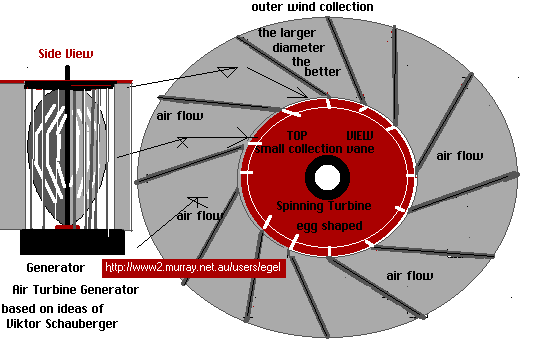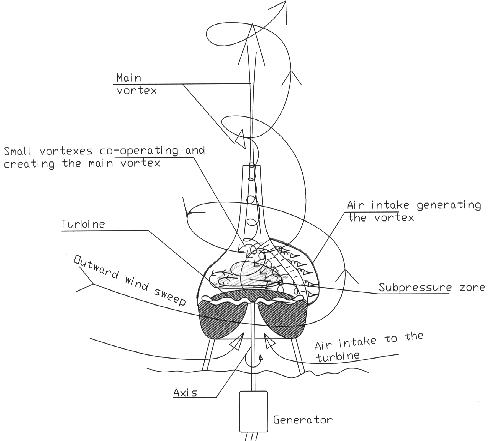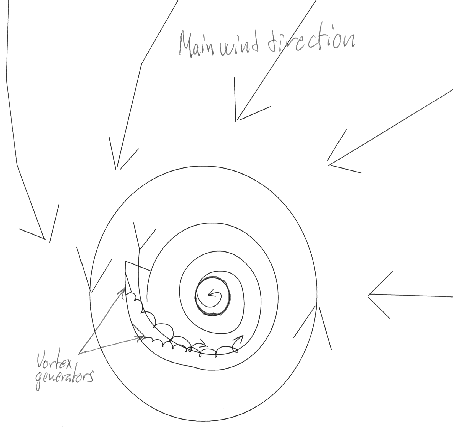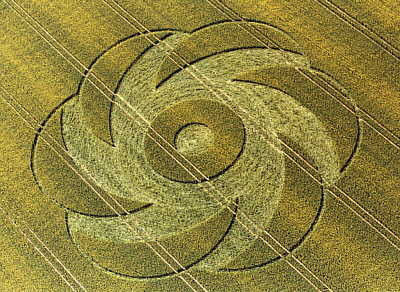


Viktor was a man that studied nature carefully to create inventions that did not go against Nature but to work with it to produce useful energy. Although this is not one of Viktor ideas I got the idea from reading the book Living Energies.
Today reaserchers are trying to make windmills that will produce electricity and more of it by making bigger wind vanes. Unfortunately the bigger they get the more damage they suffer when rotating and have speed controls to prevent destruction..
Nature when it wants to produce large amounts of energy gathers it from a large area and compresses it in to a small area ,for example cyclones and tornadoes.
This is what my idea is based on .
Wind is collected from any direction by means of stationairy vanes curved slightly and reducing in size from a large starting collection point and directed to a small area directing compressed air in a cyclonic motion towards a spinning egg shaped turbine that turns a electrical generator DC or AC..
The direction the vanes are curved will determine the direction of the turbine and will then allow wind flow to be collected from any direction. The vanes need to curved so that air flow is directed towards the centre flow and not out through another wind input area.
The egg shape was choosen because it has unusual properties and allows the fast moving air to gradually slow down as it approaches the bottom of the egg turbine and so not cause any damage to equipment.
Please note the stationairy collecting vanes can be any size the bigger the better but securely anchored to prevent movement by wind gusts.
The centre turbine must be free to rotate in any direction.
The blades on the turbine need only to extend from the hub a small distance but must follow a spiral path from the top to the bottom of central hub. This idea could be used with the newer DC brushless generators to produce really efficient operation and possibility with reduce wear.
IF you build one let me know how you get on.
I have just seen the following crop circle and am wondering if it could represent a type of schauberger centipedal Air or water turbine
would be interesting to build one I would think.
and reproduce it here for the interest and benefit of others
In these pictures I am trying to explain what my idea is. The main wind blows at the mill and some part of it
is lead into the mill. Just inside the "main air intake" there are several vortex generators (see Viktor Schaubergers patent number134543, fig 5) that will generate many small vortices. These will co-operate and wind together. As the wall of the "barrel" forces the vortices to circulate in this creates the main vortex.
Compare vortex into a vortex etc etc. However, the main vortex raises up and forces to converge folowing the walls. As the diameter of the main vortex gets smaller the rotation speed increases. When the rotation speed increases in the main vortex this accelerating
SPINNING movement increases in every little vortex, all in all this generates a subpressure in the chamber.
This subpressure sucks air through the turbine which starts to rotate as the air blows on the tubine vanes at the
rim of the turbine. As the rotation of the turbine increases the air between the "membranes" of the turbine starts to
spin into long threads of air. The two membranes in the turbine are not counter rotating but the lower one is mounted in the body of the mill and the other rotating on the generator axis. The air between the membranes starts to rotate too creating the threads. As the perifraical speed increases due to the larger radius the threads will be more and more twisted together. When they are leaving the mambranes they will blow very hard on the turbine vanes creating torque around the axis, helping the rotation and acts as a source of power to the generator.

Figure 1

Figure 2

Items needed
fresh water
a 30 cm by 10 cm Plastic jar or glass jar
a wooden dowel approx 48 cm by 1cm diameter
One ping pong ball fill with salt water and then sealed at the filling end to prevent brine leakage.
A fresh egg
METHOD
Fill the jar with fresh water.
drop both the filled ping pong ball and the egg into the water and watch them sink to the bottom of the jar.
Now if you gently stir with the wooden dowel the water level at the top of the jar (5cm-10cm in depth)
you will notice the egg will lift from the bottom towards the top of the jar but the ping pong ball will stay at
the bottom. (Interesting that nature choose such an interesting shape to bring life into the world with )
Try this with other shapes of similiar density to see what happens also.


